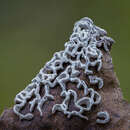Comprehensive Description
provided by North American Flora
Physarum bivalve Pers. Ann. Bot. Usteri 15: 5. 1795
Reticularia sinuosa Bull. Hist. Champ. Fr. 94. 1791. Angioridium sinuosum Grev. Scot. Crypt. Fl. pi. 310. 1827. Diderma valvatum Fries, Syst. Myc. 3: 109. 1829.
Physarum sinuosum Weinm.; Fries, Syst. Myc. 3: 145. 1829. Not P. sinuosum Iyink, 1809. Carcerina valvata Fries, Summa Veg. Scand. 451. 1849.
Diderma contortum sensu Fuckel, Jahrb. Nass. Ver. Nat. 23-24: 341. 1869. Not D. conlortum Hoffm. 1795.
Plasmodiocarpous, crowded, laterally compressed, white, gray, or yellowish, the plasmodio carps usually interspersed with shortened, sporangiate fructifications, these sometimes with a constricted base; peridium double, the outer layer usually thickly calcareous, especially above, and then white, sometimes nearly limeless below and then drab or yellowish, the inner wall delicate, colorless; dehiscence by a more or less regular longitudinal fissure; capillitium abundant, the nodes large, white; spores black in mass, dull violet by transmitted light, minutely and uniformly spinulose, 8-10 /* in diameter; Plasmodium gray, pallid, or yellowish.
Type locality: France.
Habitat: Dead leaves and accompanying debris.
Distribution: Throughout North America; cosmopolitan.
- bibliographic citation
- George Willard Martin, Harold William Rickett. 1949. FUNGI; MYXOMYCETES; CERATIOMYXALES, LICEALES, TEICHIALES, STEMONITALES, PHYSARALES. North American flora. vol 1. New York Botanical Garden, New York, NY

